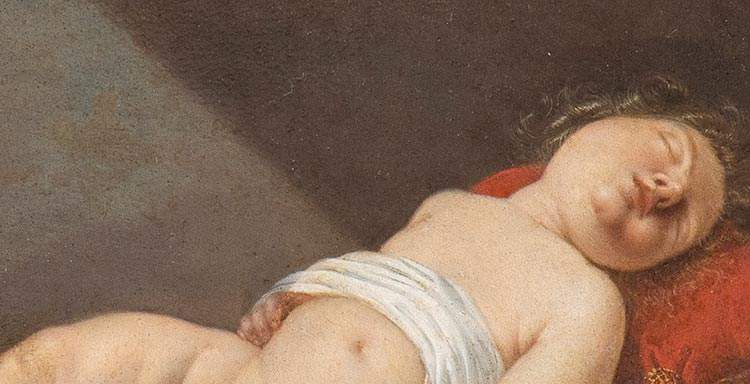Bertolami Fine Art ’s spring auction of Old Masters to be held today at 3 p.m. continues to hold surprises. In addition to the news of the presence in the catalog of an unpublished masterpiece by Romanino is the news of a resounding attribution to Artemisia Gentileschi for a small copper, depicting a Sleeping Child, which Bertolami’s experts at first listed as an anonymous 17th-century Roman School production.
The interest created around the work prompted Luca Bortolotti, head of the Roman auction house’s department of ancient art, to proceed to more in-depth studies. “The transparency of public auction sales is often the spring of new discoveries and significant insights in the field of art history studies,” he said. "Then, since auction houses have appropriated some of the most innovative online sales technologies, every work published in our catalogs is under the eyes of connoisseurs and scholars from all over the world, a truly favorable conjuncture from a scholarly point of view. The attention that international experts immediately paid to that 13x18 cm rectangle obviously put us in a position where we had to proceed with further investigation. In consultation with the owners, we withdrew the copper from the auction to subject it to an analysis that could support the rumors coming in from the connoisseur community. The discovery of a full-bodied web of relationships between our Sleeping Child and a small autograph copper by Artemisia recently acquired by the Museum of Fine Arts, Boston, now induces us to offer the work for sale again with an attribution to the Caravaggesque painter."
Change of attribution, then: now the work goes up for auction as “attributed to Artemisia Gentileschi,” with revised estimate, since it has been raised to 12,000/25,000 euros, because, the auction house explains, “Our estimates in the current state of knowledge about the painting mean little. The truth is that the price will be formed at auction. The competition will, as always, be the moment of truth, the one in which we will understand to what extent the small world of Old Masters collectors will be willing to bet on Artemisia’s name. After that, the floor will pass to the painter’s experts for the in-depth analysis that this delightful copper painting undoubtedly deserves.”

 Artemisia
ArtemisiaThe painting purchased by Museum of Fine Arts, Boston, in a Christies auction on April 20, 2022 differs from the one put up for auction by Bertolami only in two elements: the color of the cushion on which the child rests his head (green the Boston one, red the Bertolami one) and the presence of the signature “Arte. Gentilesca / fecit Napo,” where the copper in the auction, on the other hand, bears no inscription whatsoever. The information “Fecit Napo” allows us to place the execution of the painting in the period of the painter’s long stay in Naples, which began, as is known, in 1630.
The appearance on the market of the painting later purchased by the Boston museum also had in its time the no small merit of opening a significant window on a little-known production by Gentileschi of almost miniature format and on copper, destined for a very elect private collector. Should the studies of which the sleeping child in the Bertolami auction will surely be the subject confirm Artemisia’s authorship, it would be the fourth known example of this type of work.
In the course of the studies that have analyzed the Boston painting, it has also emerged that there is fundamental information about the description of a painting depicting a sleeping putto in both the post mortem inventory of Prince Flavio Orsini, drawn up in 1698, and in the inventory, drawn up in 1723, of the property left by his wife Anne-Marie de La Trémoille. The inventoried painting, listed as the work of Artemisia Gentileschi, appears entirely similar to both the Boston and Bertolami paintings: in terms of the technique of oil painting on copper, the measurements and the subject, illustrated as a sleeping child on a red cushion.
Luca Bortolotti explains, “The curators of the Boston Museum themselves have always noted that the description of Artemisia’s painting in the Orsini inventories differs from the work in their possession only in the detail of the color of the cushion, green in the Boston exemplar, where it is instead red in the version auctioned in our auction.” Here then is explained the reason for the uproar caused by the appearance on the market of the Bertolami Fine Art copper: suddenly a version had emerged, of similar quality to the Boston copper, but perfectly consistent with the description of the painting in the Orsini collection.
 |
| Possible Artemisia Gentileschi painting pops up at Bertolami auction |
Warning: the translation into English of the original Italian article was created using automatic tools. We undertake to review all articles, but we do not guarantee the total absence of inaccuracies in the translation due to the program. You can find the original by clicking on the ITA button. If you find any mistake,please contact us.